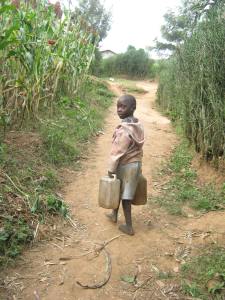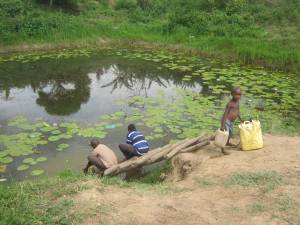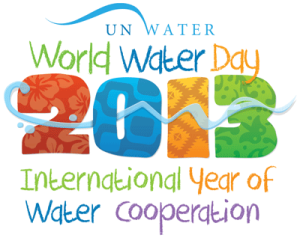Hope Mafaranga
March 19, 2013
As the world marks World Water Day this week, several countries in Africa are still far from achieving the millennium development goal 7 C despite efforts in place.
This goal calls for halving, by 2015, the proportion of people without sustainable access to safe drinking water and basic sanitation.
One of such countries is Uganda, where areas in the western, eastern and Northern Uganda continue to cry foul over not only poor water sources but also the long distances women and children travel to fetch water.

A world health organization report in 2012 showed that an estimated 780 million still lacked safe drinking water in 2010 underlining the fact that target C of the millennium goal 7 is far from being achieved.
In western Uganda, people living in hilly areas have no access to piped water while the few water sources are down the hill slope and in the valleys far away from their homes.
Alfred Bikitwoha, a resident of Kashuro Village in Mbarara district western Uganda reveals that his family gets water from a spring over 5 kilometers away.
“We share the spring with other 3 villages. Because of the high number of people and the long distance, we spend 4-5 hours fetching water depending on the number of people you find there,” a visibly tired Bikitwoha revealed adding that his wife gets up as early as 6 am to go to the spring.

As if this is not enough, during the dry spell, this spring runs dry at times complicating lives much more. The situation in Kashuro is similar to what is happening to several other regions of Uganda.
The Mbarara district Assistant Water Engineering Officer, Engineer Joseph Mucunguzi says that the mountainous nature of the area coupled with limited resources is making pumping of water to this area difficult.
In a desperate move, residents have resorted to shrewd but unhealthy ways of keeping water.
James Nuwagaba one of the residents in western Uganda has dug a 40-fit pit to tap water that flows during the rainy season.
This water is what the family uses for all their domestic needs. Those who see Nuwagaba’s style as more advanced collect water off the roofs in jerry cans, pots and sauce pans when it rains.
Some use this water to drink even without preparing it, something that has worsened the burden of water-borne diseases.
Rosette Mutambi – the Executive Director of HEPS Uganda says this is not just a water issue but also leads to local people’s poor health.
“ The issue of health is threat to people’s lives because they suffer from water borne diseases which they should not have if at all they had safe and clean water. As a result, government spends much on drugs more than preventing the diseases,” she says.
She wants government to address this issue urgently.


Reblogged this on Friend Nature and commented:
Water Consciousness! Please raise your awareness when you use this valuable resource, it is precious! Friend Nature recycles all water at least 2 times. The bath water is used for the flush, or pumped outside into a water barrel, or carried to the laundry room run a washing load. That water is recycled into the garden after the wash. I come from an area with vast amounts of clean drinking water, yet to do otherwise would go against my nature, Friend Nature.
Thank you for your article. I re-blogged this post on my Word Press site, Friend Nature.
D.A. Hartley